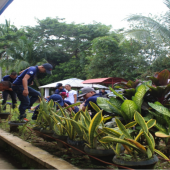
The participation of youth in any disaster risk reduction activities could be enhanced when they have high levels of awareness on climate change. But there seems to be scanty information about their level of awareness. The study was conducted to investigate the level of awareness of youth studying in a state university in the Philippines, and to determine the factors that influenced their awareness. The study employed the descriptive survey method using a 5-Lickert scale instrument involving the students of Partido State University (PSU), Camarines Sur, Philippines. Respondents (n = 247) were selected randomly from the undergraduate student population, and were stratified by their year levels. Although there was no qualitative difference observed among the respondents, the computed weighted mean for all variables under investigated differ across year levels. Based on the computed weighted mean, level of awareness is generally higher among senior students than first year students. Similar observations were made for all variables, i.e. computed weighted means increase as year level increases. In addition, the factors perceived to be significantly influencing the level of awareness of the respondents have differed across year levels. First year students perceived personal experience while second and third year students as well as fourth year students perceived education and government actions, respectively as much important factors that could influence their level of awareness. The channels of information about climate change also differ across year levels based on the computed weighted means. Among the four channels presented in the survey, first and second year students perceived mass media and family and trainings and seminars, third year students perceived internet and social media, and fourth year students perceived education, mass media and family and trainings and seminars as important channels of information. Overall, the differences could be utilized as bases in developing academic as well as extracurricular activities that are sensitive to the sex and year level of the involved students to improve their cognitive adaptive capacity.
Continue Reading